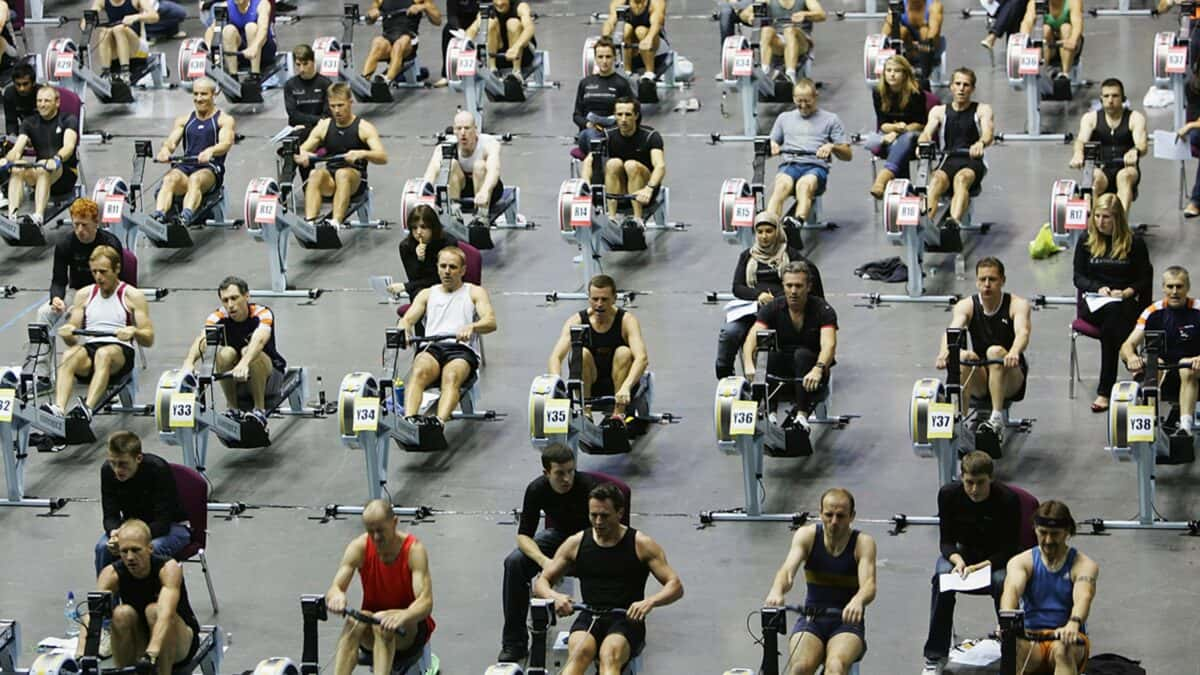
16 Dec 2016
Insider’s guide to static machines and rowing training
My guide through this process was Australian World Champion coach, Phil Bourguignon. Bourguignon is currently chief coach at one of British Rowing’s high performance centres – Molesey Boat Club. Walk into the gym and you’ll see a row of Concept2 static rowing machines, a couple of old Watt Bikes, a leg-press machine and squat ‘cage’. There’s only one Concept2 dynamic erg – currently under repair. Hardly an endorsement for static machine use. The rest of Molesey’s gym is taken up with free weights.
Appearances can be deceiving though. I remember walking into Chelsea Football Club’s Cobham training centre gym a few years ago, which was absolutely rammed–full of expensive new and largely unused fixed weights machines. And the reason for their presence and under-use: they’d just changed their manager and the new coaching philosophy didn’t fit with the use of static weights machines.
So I asked Bourguignon why there weren’t more static machines in the Molesey gym. “Well, I’d love to have more static weights machines if the club had the resources to buy them. But our first priority here is to buy more boats and blades. And when you’re talking 4 to 5,000 pounds ($USD5500) for a fixed weights machine, you’ve got to be absolutely clear what the benefits might be.”
Bourguignon went on to highlight the benefits to using static machines. “If you’re using a static machine, it can effectively control your movement range. That can be especially important during rehab from injuries. Then you can be very safe and specific and the athlete feels supported and confident.”
The club has its fair share of junior rowers, so it’s not surprising that the Australian saw potential benefits for them. “If you are a young rower, you probably don’t have the full development of your musculature to support free weight lifts. Even some of the under-23 rowers we get at Molesey have only been rowing a couple of years and there’s a lot of development to do. So you might use a fixed weight machine as part of a programme to develop your musculature so you can lift free weights more effectively. Then there are some specific exercises that you just can’t do with free weights: like a lat-pull down.”
Bourguignon then explained how what he wanted on the water was intrinsically linked to what his crews did in the gym. “The crucial thing for me in the land training is to look at the movement patterns I want to see in the boat and see how I can try and replicate that on the land. I see most technical issues in the boat as usually caused by a physical weakness. If you’re looking at a rower’s position at the front of the stroke – maybe they’re a bit slumped – you could tell them to sit up till you’re blue in the face but nothing changes. To do that, I target strength and conditioning work and particular lifts, like power cleans.”
Bourguignon underlined just how crucial it is to have a background in strength and conditioning and he has called on experts that know the rowing stroke. “When I worked with the British eight that won the FISU (university) Championships this year, the strength and conditioning sessions – with emphasis on the trunk and core – were an important part of our programme.”
I then pressed Bourguignon on the use of fixed-exercise bikes. “It’s important to recognise that both cycling and swimming are very closely related to rowing in both the type of work that’s necessary and volume of aerobic training undertaken. If clubs have issues outside of their control on how much water time they can get, you have to supplement their volume training in other ways – like the exercise bike. Also for rehab, especially from back injuries, the static bike is the best device.”
Bourguignon, however, prefers his rowers to get out on the road. “I use road-biking as an additional session. If I want to do a high volume week, I send the guys on a 3-4 hour ride. To get that sort of training volume in the boat, you’d have to row over a couple of days. It’s also difficult to do that sort of training volume on the rowing machine because it may lead to more injuries. Cycling also takes people out of getting too ‘insular’ as rowers and learn a new skill, which ultimately helps them become better athletes.”
There’s debate in the sport on how rowing machines best fit into land training. For Bourguignon he uses them for the physiology side. “I don’t see the machine as a technical tool. For example if I’m trying to get them to speed up their catches, I don’t do it on the rowing machine. That said, we’ll do enough to get the basic body posture right and the ‘erg’ does give you a way of quantifying the work (through lactate testing).”
What about static versus dynamic rowing machines? “There’s no doubt that Concept2’s dynamic erg is better to develop rowing technique. It and other similar ergs replicate a really good feel for the stroke. You can make sure you sit still on the front and experience your knees pushing away from you,” says Bourguignon.
”I use sliders (rails that static ergs can slide up and down on) quite a bit,” says Bourguignon. “Basically, it’s a poor man’s dynamic. You can really see the benefits in cohesion when the crews get back on the water.”
Ultimately Bourguignon knows context is everything: both the needs of individual athletes and the environment they work in.

